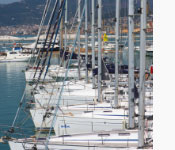How to Moor Safely in a Port
 |
Anyone who owns a boat knows this very well: mooring operations require dexterity, maximum attention and above all maximum competence. If the navigation itself must be carried out very scrupulously, mooring requires some extra care and should not be underestimated. In order not to encounter unpleasant inconveniences, the advice is [...] |
Anyone who owns a boat knows this very well: mooring operations require dexterity, maximum attention and above all maximum competence.
If the navigation itself must be carried out very scrupulously, mooring requires some extra care and should not be underestimated.
In order not to encounter unpleasant inconveniences, the advice is to ask boaters for direct assistance at sea, turning only to specialized companies also present on the web such as www.sea-help.eu/it/, which thanks to the expertise of professionals industry, offers all kinds of support around the clock.
It therefore becomes clear that it is essential to know which mooring operations are to be carried out correctly, without creating problems for other boats.
Have a suitable place
Having a suitable docking point does not arise the problem. However, it is not always possible to choose the most suitable place for mooring and it will therefore be necessary to follow the instructions of those in charge.
If there is no reference staff present at the time of mooring, you must pay close attention to the place you choose, because it could be reserved for the harbor master, ferries or other means of transport.
To avoid being in the way of other boats, a small trick that could be adopted in this case is to temporarily moor your boat in a pier.
Mooring operations to be performed
Depending on the weather conditions, various mooring operations can be performed, such as:
• stern mooring: this type of mooring is recommended when the weather conditions are rather favorable and therefore reversing maneuvers are quite easy. This is one of the most adopted solutions because the stern faces the quay and this allows the possibility of arranging the gangway for the descent and for carrying out any exit operation in a much more practical and easy way;
• mooring in the bow: this mooring method is adopted when the weather conditions are not entirely favorable and therefore in order to ensure a good reversing maneuver, the bow is turned towards the quay;
• English mooring: this operation, which is not always permitted, is used to place one side of the boat in favor of the quay in order to facilitate getting on and off the boat.
Ropes and cables
Another very important aspect to consider is that of the use of ropes and cables for the safety of the boat. Naturally, for a correct use of these elements it is necessary to know the knot techniques.
Furthermore, it should be emphasized that an abundant use of fenders is effective and very useful in the event of the absence of dead bodies or strong backwash.
Administrative aspects related to mooring
The yachtsman who lands in a particular marina must be aware of every administrative and bureaucratic aspect of the port, in order not to face penalties.
The same must deliver the navigation license and the documentation of his crew to whoever is responsible.
Release the moorings
At the time of departure, the yachtsman has the opportunity to express the satisfaction of the services offered during mooring.
In this way, in the event of inefficiencies, whoever is responsible will take care of improving the aspects reported.




